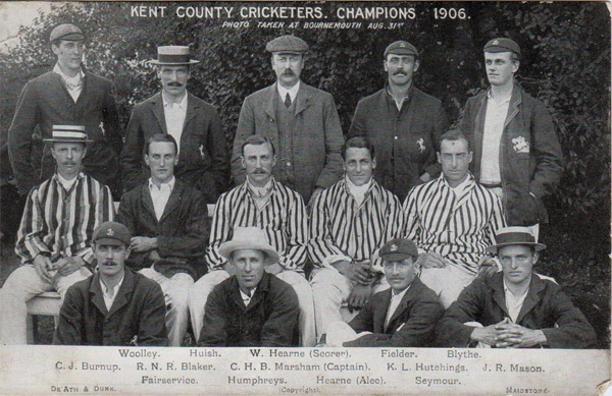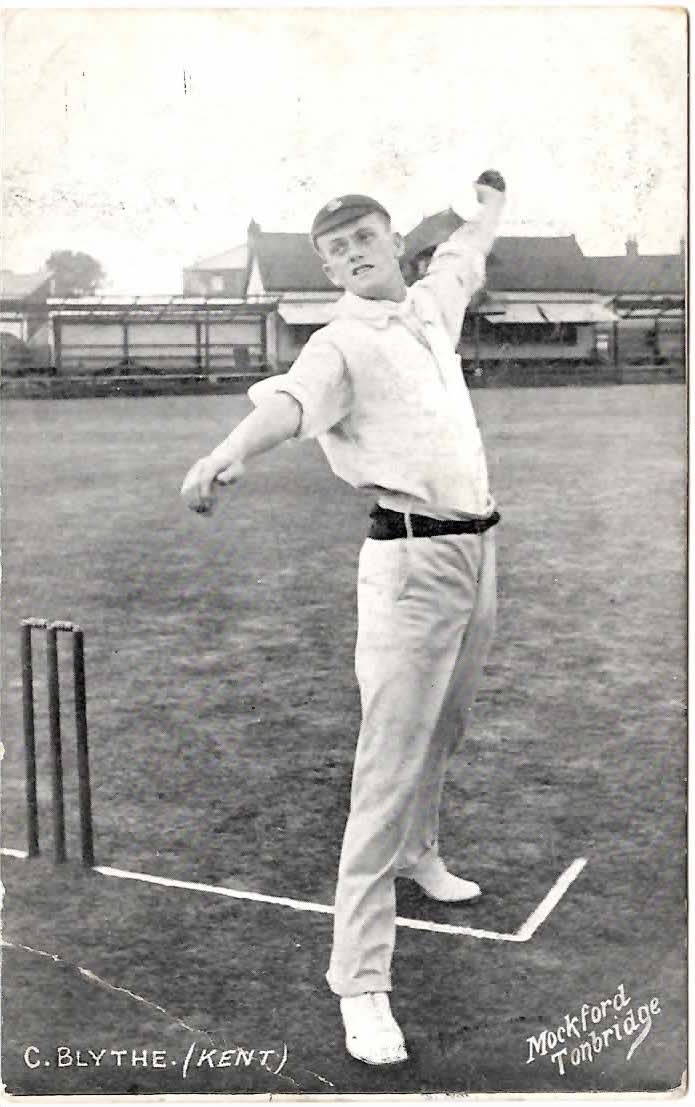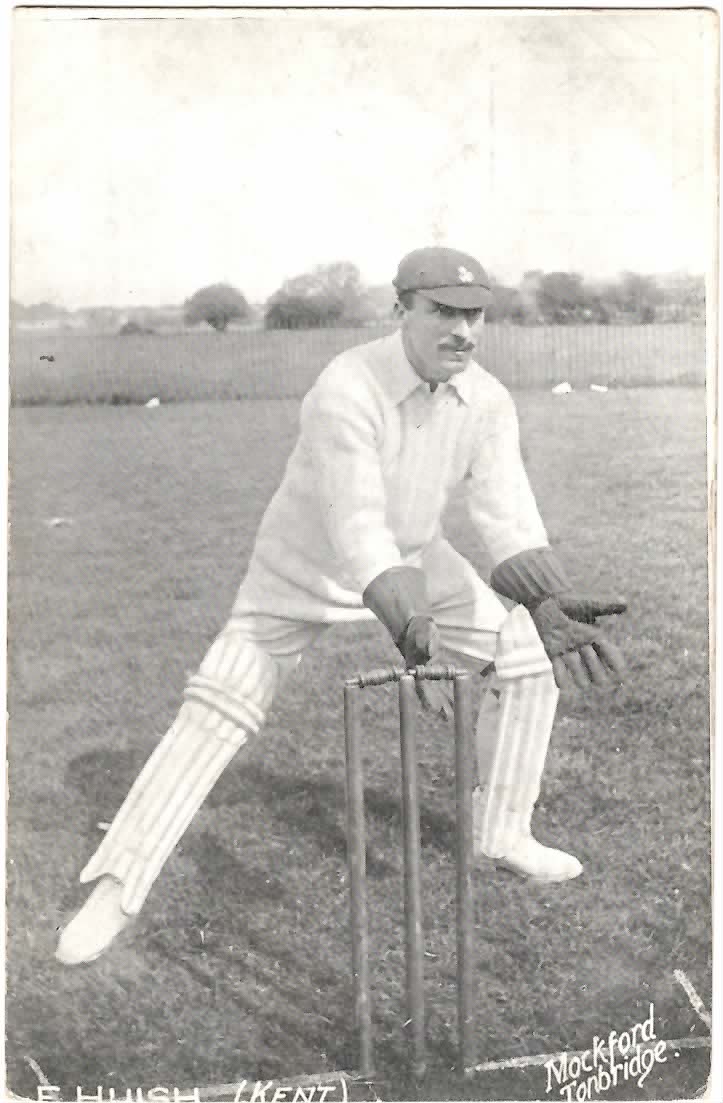Continuing the history of the club, based on the original website article written by the Hon. Curator of Kent CCC, David Robertson.

In 1906 Kent achieved its first County Championship success. Wisden’s Cricketers’ Almanack of 1907 said: “that they played the finest cricket of the year and fully deserved the distinction they earned was admitted on all hands.” In only 2 matches out of 22 that season was Kent defeated and those two defeats came in the first five matches at which point, the middle of June, there seemed little likelihood that the title would come to the County. However, it was a close run thing, Yorkshire only being deprived of the title as a result of a one run defeat by Gloucestershire. The turning point came in the match against Surrey at the Oval on 14th and 15th June, which Kent won by just one wicket, inflicting on Surrey its first defeat of the season. This was the match in which Frank Woolley confirmed his outstanding promise as an all-rounder. Going in at number 8 he scored 72 out of a total of 200 in the first innings, and in the second, with Kent requiring 128 to win he held on to be undefeated with 29 runs. His combined batting and bowling won the match, as he also had eight wickets to his name, three in the first innings and five in the second.
The return match with Surrey, at Blackheath at the end of July, was no less remarkable. Kent started their second innings with arrears of 83 and lost their first three wickets for 58 runs before recovering to a total of 327. That left Surrey with 245 to win, but superb bowling by Colin Blythe, who took 5-25 in 20 overs, gave Kent victory by 164 runs, setting them up for two wonderful wins during the Canterbury Week. The first of these against Sussex resulted in victory by an innings and 131 runs after Kent had scored 568 in 120 overs. The second victory, against Lancashire, was even more emphatic, with Kent winning by an innings and 195 runs after scoring 479 and Arthur Fielder taking 11 wickets in the match for 130 runs. This is the match which was the subject of the famous painting by Albert Chevallier Tayler, a copy of which hangs in the Chiesman Pavilion at Canterbury.
Despite these wins, at this stage in the season it looked as though Kent could not win the title unless Yorkshire suffered a reverse. The climax came on 25th August when Kent secured victory over Worcestershire at Canterbury at the same time as Yorkshire were suffering defeat at Bristol by a single run. With two matches remaining the title was still not certain and although Kent defeated Middlesex at Lord’s, they still needed to avoid defeat against Hampshire in the final match. Not only did they do so, they won by an innings with another mammoth total, on this occasion scoring 610 runs in 130 overs. This was the team’s twelfth successive victory.
One of the remarkable things about the season was that the first five places in the county batting averages were all taken by amateurs who between them scored 4,256 runs including 10 hundreds, whilst 7 of the most successful bowlers were professionals who between them took 368 wickets. Colin Blythe, who appeared in 15 matches, bowled more than 700 overs and took 90 wickets. Arthur Fielder, who appeared in all the 22 championship matches, bowled almost 1,000 overs and took 158 wickets. In a first-class career which ran from 1900 to 1914, he finished with 1277 wickets to his name, and is also famous as half of a tenth wicket partnership of 235 with Frank Woolley against Worcestershire in 1909, which is still in 2017 the largest tenth wicket partnership ever recorded in the county championship.
In those years, the determining of the County Championship was based on an entirely different formula to that which is now the case. Counties did not all play the same number of games. In 1906 Northamptonshire played the lowest number (16) whilst Surrey and Yorkshire both played the largest number (28). The M.C.C. laid down that one point would be awarded for each win, and one deducted for each defeat. Drawn games were not counted for points. Consequently, the side which obtained the most points per game, in effect losing the least number of matches, would be the champions.
Further successes in the Championship followed in 1909, 1910 and 1913. From 1906 until the First World War, Kent’s championship placings were 1st, 8th, 2nd, 1st, 1st, 2nd, 3rd, 1st, 3rd. During this time, of 188 Championship matches played, just 27 were lost. Outstanding among the bowlers in those nine seasons was Colin “Charlie” Blythe, the great left arm spinner, who took 1,328 wickets, his best return being 185 in 1909 with his lowest 138 in 1911. In only two of those seasons did he bowl less than 1,000 overs. His smallest “work rate” (if it can be so described) was in 1912 when he bowled just 920 overs but still picked up 178 wickets! Lest the reader should think these were days of easy pickings for the bowlers, this was far from the case. Some 40 to 50 batsmen were scoring well in excess of 1,000 runs in a season and a third of those close to or above 2,000.

Colin “Charlie” Blythe
For Kent, the reputation for exciting and entertaining batting prevailed through the whole of this period, with both amateurs and professionals contributing equally impressively. One game illustrates the remarkable versatility and striking power of the side in those years of success. Against Warwickshire at Tonbridge in 1913, Kent’s first innings ended at noon on the third day with a deficit of 130 runs. By 3.30 p.m. the match had been won by six wickets. Between them, Blythe and Woolley bowled Warwickshire out in 45 minutes for just 16 runs and on a wicket which was still far from easy, Woolley then scored 76 runs in 80 minutes. The left-handed Frank Woolley, who played from 1906 to 1938, scored 47,868 runs for the county, half as many again as any other batsman. He was also, of course, a bowler and fielder of the highest order.
The Tonbridge Nursery was generally more successful in producing bowlers than batsmen, but one professional who made his debuts in these glory years, went on to be a bulwark of Kent’s batting for many years. James Seymour, who first played for the county in 1902, was a fixture in Kent’s middle order from then until 1926, during which time he scored 26,818 runs. He hit 53 centuries for the county, and scored more than 1,000 runs in a season 16 times. Also in 1902, Wally Hardinge made his debut, and played on until 1933, by which time he had amassed 32,549 runs for the county, and established an opening partnership with Ted Humphreys, whose Kent career ran from 1899 until 1920. Among the amateurs, Kenneth Hutchings, the brothers Arthur and Sammy Day and Ted Dillon, who captained the side from 1909 to 1913, were some of the mainstays. Then there was Fred Huish, the first of Kent’s great wicket-keepers, who in 1911, at the age of 42, claimed one hundred victims behind the stumps, the first time that feat had ever been achieved. Kent in the years leading up to the Great War had a very strong side.

Fred Huish
To be continued….
What event marked Kent’s first County Championship success, and in which year did it occur?
Visit us S2 Akuntansi
Kent’s first Championship success was in 1906. At the end of the season there were many dinners and other celebrations to mark the success.